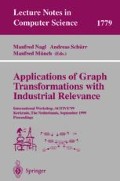Abstract
PROGRES is the first strongly typed graph rewriting language. Its programming environment supports the specification, rapid prototyping and implementation of abstract data types with graph-like internal data structures. The main application area for this language is the development of complex internal data structures for software development tools and environments. In this article we present the PROGRES system, parts of its functionality and a rapid prototype generated of a PROGRES specification.
Access this chapter
Tax calculation will be finalised at checkout
Purchases are for personal use only
Preview
Unable to display preview. Download preview PDF.
References
H. Ehrig, G. Engels, H.-J. Kreowski, and G. Rozenberg, editors. Handbook on Graph Grammars and Computing by Graph Transformation: Applications, Languages, and Tools, volume 2. World Scientific, Singapore, 1997.
H. Göttler, J. Günther, and G. Nieskens. Use graph grammars to design CAD-systems! In H. Ehrig, H.-J. Kreowski, and G. Rozenberg, editors, Graph Grammars and Their Application to Computer Science, volume 532 of Lecture Notes in Computer Science, pages 396–410, 1991.
M. Himsolt. GraphEd: An interactive graph editor. In B. Monien and R. Cori, editors, STACS’89, volume 349 of Lecture Notes in Computer Science, pages 532–533, 1989.
N. Kiesel, A. Schürr, and B. Westfechtel. Gras, a graph-oriented database system for (software) engineering applications. Information Systems, 20(1):21–51, 1995.
M. Nagl, editor. Building Thightly Integrated (Software) Development Environments: The IPSEN Approach, volume 1170 of Lecture Notes in Computer Science. Springer Verlag, Berlin, 1996.
J. Paredaens, J. Bussche, M. Andries, M. Gemis, M. Gyssens, I. Thyssens, D. van Gucht, V. Sarathy, and L. Saxton. An overview of GOOD. ACM SLGMOD Record, 21(1):25–31, 1992.
A. Schürr, A. J. Winter, and A. Zündorf. Progres: Language and environment. In G. Engels, H.-J. Kreowski, and G. Rozenberg, editors. Handbook on Graph Grammars and Computing by Graph Transformation: Applications, Languages, and Tools, volume 2. World Scientific, Singapore in [1], pages 487–550. 1999.
Author information
Authors and Affiliations
Editor information
Editors and Affiliations
Rights and permissions
Copyright information
© 2000 Springer-Verlag Berlin Heidelberg
About this paper
Cite this paper
Münch, M. (2000). PROgrammed Graph REwriting System PROGRES. In: Nagl, M., Schürr, A., Münch, M. (eds) Applications of Graph Transformations with Industrial Relevance. AGTIVE 1999. Lecture Notes in Computer Science, vol 1779. Springer, Berlin, Heidelberg. https://doi.org/10.1007/3-540-45104-8_36
Download citation
DOI: https://doi.org/10.1007/3-540-45104-8_36
Published:
Publisher Name: Springer, Berlin, Heidelberg
Print ISBN: 978-3-540-67658-4
Online ISBN: 978-3-540-45104-4
eBook Packages: Springer Book Archive

